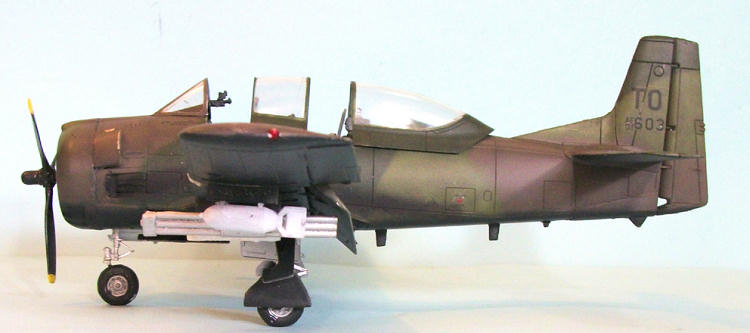
Roden 1/48 AT-28D 'Trojan'
| KIT #: | 441 |
| PRICE: | 3680 yen at Hobby Link Japan |
| DECALS: | Three options |
| REVIEWER: | Tom Cleaver |
| NOTES: |
Modified to AT-28D configuration |

| HISTORY |
The North American T-28 began life in 1946 as the XSN2J-1, which was
designed to replace the SNJ trainer for the Navy. Looking like a tailwheel T-28,
the design was not accepted by the Navy, but in 1947 the Air Force issued a
specification for a new trainer to replace the T-6.
It was to use the Wright R-1300 radial engine of 800 h.p. (The engine was
an R-2600 cut in half), and should have tricycle landing gear to emulate the
performance of a jet-powered aircraft.
North American took up their failed Navy design and modified it to meet
the Air Force requirements.
In May
1948, the Air Force announced the selection of the BT-28, and North American
proceeded to create two flying prototypes, which first flew on
The Trainer That Went To
War:
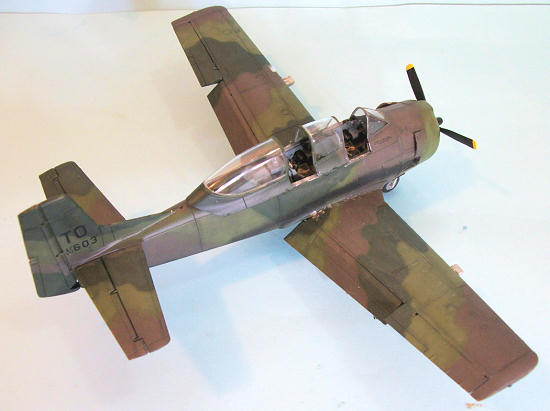 In 1960, the Tactical Air Command was directed to form a
counter-insurgency force which could train allied and friendly air forces to
fight limited wars against guerilla forces, which came to be known as the Air
Commandos.
In 1960, the Tactical Air Command was directed to form a
counter-insurgency force which could train allied and friendly air forces to
fight limited wars against guerilla forces, which came to be known as the Air
Commandos.
The T-28As were all fairly “weary” from their years in training command.
The first thing that had to be done was to give them a bigger engine;
Wright R-1820s were taken from recently-retired SA-16 Albatross aircraft, and
installed in the T-28s, which received a new cowling similar to that used by the
Navy’s T-28B and T-28C trainers which were powered by this engine.
The wings of the newly-designated T-28D were strengthened to allow the
aircraft to carry up to 4,000 pounds in underwing stores.
The 50-caliber gun pods that had been developed for gunnery training in
the T-28 were used; two different pods were used, one with 100 rpg which kept
the spent shells inside the pod, and a larger pod with 500 rpg.
When the definitive AT-28D was developed, the gun pod was changed to a
more aerodynamically-clean one that had ammo bays in the wing.
As the T-28D, the aircraft had two underwing pylons on each wing in
addition to the self-contained gun pods, while the AT-28D had three pylons under
each wing.
Top speed was 345 mph,
with
a rate of climb of 3,780 fpm.
Between 1961 to 1969, North American received 13 production contracts to
convert 371 T-28As to T-28Ds. Additionally, Fairchild Aircraft converted 72
T-28As to AT-28D-5s; many of these were later equipped with the Yankee
extraction seat similar to that used in the A-1 Skyraider.
The first armed T-28s to see action were flown by the 4400th
Combat Crew Training Squadron at Eglin AFB.
In 1961, President Kennedy authorized the deployment of a detachment from
the 4400th CCTS to South Vietnam under the code name “Farm Gate,”
While the primary mission was to train South Vietnamese Air Force pilots,
the Air Force pilots were authorized to fly combat missions so long as a South
Vietnamese pilot was aboard.
“Farm
Gate” also brought along a group of B-26B Invaders for evaluation.
By 1962, the VNAF 2nd Fighter Squadron was operational.
In 1963, the 4400th CCTS detachment was renamed the 1st
Air Commando Squadron (Composite) and continued to operate T-28D and B-26B
aircraft.
In 1964, it was decided
that the VNAF would upgrade to the A-1 Skyraider and the Air Force “officially”
left the T-28 business.
The Laotian, Thai and Cambodian Air Forces were also equipped with the
T-28D, with the Laotian aircraft becoming involved in what was known as “the
secret war” which would eventually involve combat with North Vietnamese forces
in
The “Zorros”:
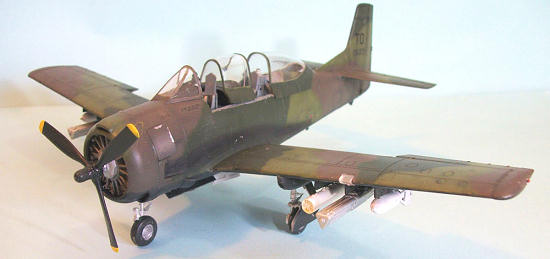 By 1965, as the United States formally intervened in Vietnam, the North
Vietnamese began the construction of what became known as the Ho Chi Minh Trail,
which extended from North Vietnam into Laos and Cambodia and then into South
Vietnam, for supply of communist forces.
Pilots like Norm Crocker, by then a junior Air Force Captain flying as a
co-pilot in B-52Ds, flew strikes against the trail at Mu
By 1965, as the United States formally intervened in Vietnam, the North
Vietnamese began the construction of what became known as the Ho Chi Minh Trail,
which extended from North Vietnam into Laos and Cambodia and then into South
Vietnam, for supply of communist forces.
Pilots like Norm Crocker, by then a junior Air Force Captain flying as a
co-pilot in B-52Ds, flew strikes against the trail at Mu
The 56th Air Commando Wing was deployed to Thailand in 1966 as
part of the “Lucky Tiger” program to work with Thai and Laotian units to develop
counter-insurgency operations in northern Thailand and Laos.
One of the units of the 56th ACW was the 606th Air
Commando Squadron, equipped with the Fairchild-modified
AT-28D; their official assignment was to train Thai and Laotian pilots
for combat, and support the Laotian Army in central Laos, operating out of
Nakhon Phanom Air Base in Thailand (NKP).
Unofficially, the 606th was also tasked with flying night
interdiction air strikes on the Ho Chi Minh Trail.
C-130 pilot Jack Drummond flew the first group of 606th pilots
from Bangkok to NKP in October 1966.
When he heard what the mission was to be, he knew he wanted to be
involved.
“I knew everything there
was to know about the target. I went back and volunteered straight out.
It would be a chance to finally shoot back at all those guys who had been
shooting at me.”
Drummond was
immediately accepted and sent to Hurlburt Field in Florida for Air Commando
training, returning to Southeast Asia in March 1967.
A Zorro mission lasted between an hour and a half to two hours, with
takeoff around 0230 and return around 0430 during the dry season.
Operations over the Trail at night involved a Forward Air Controller; in
the early days these were Cessna O-1s, but they were soon replaced by the faster
Cessna O-2A.
The FAC searched for
trucks, flying at anywhere from 500 feet to 1,500 feet above the trail with a
second pilot searching the ground below with a starlight scope to spot movement.
When the trucks were found, an AT-28D would be called in to hit the
targets, aiming to stop the first and last truck in the convoy and trap the
rest, at which point an A-26 “Nimrod” (the Counter-Invader remanufactured by
On-Mark) would come in to hit the convoy with its 8 50-caliber machine guns and
heavier bombs.
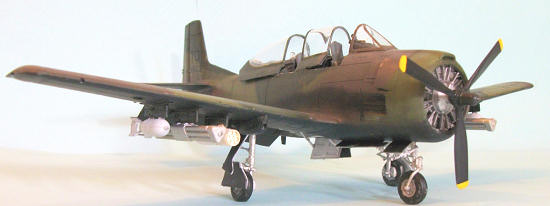
The 606th callsign, “Zorro,” has an interesting story behind
it.
Originally, 56th ACW
requested the callsign “Sabre” for the AT-28Ds, but an F-100 squadron at Tuy Hoa
AB in South Vietnam was already using that.
When it was discovered that “Zorro” was available, it was adopted because
it represented a hero who performed good deeds fighting bad guys at night.
A “Zorro” squadron patch was designed: a black background with a red mask
and sword, with “Zorro” over both in white, with the “Z” slashed as it was in
the TV show.
The AT-28D wasn’t the ideal airplane for the mission, as Drummond
recalled.
“The big problem with
using the T-28 in combat in our situation was you had no energy to evade with.
You were diving at 250 knots, and while you could turn tight, you didn’t
move through the air fast enough to evade the flak. Before there were too many
guns on the Trail, we did missions into North Vietnam too.”
By the time he left the 606th in April 1968 to “cross the
river” and become an advisor to the Laotian Air Force, Jack Drummond had flown
more than 120 missions at night over the Ho Chi Minh Trail in the AT-28.
“By early 1968, they were keeping us away from the ‘red areas,’ where the
guns were heavy, which meant we weren’t going where the trucks were.
I got bored with the mission.
I volunteered to go across the river to Laos as an advisor to the Laotian
Air Force and spent six months on that tour. Officially, we were advisors only,
and were not supposed to fly combat, but I flew many ‘test flights’ where we
took off with ordnance and returned without ordnance.”
SAC B-52 pilot Norm Coleman came to the 606th in the fall of
1967 after flying 49 combat missions in the B-52.
“When I saw the requests for volunteers for T‑28s, I was told I couldn’t
be accepted because I had access to the War Plan and clearance.
So I volunteered again for A‑26s and was told the same thing.
After I un‑volunteered, I was given orders in October 1967 for T‑28s.”
When Coleman arrived at the 606th, he made his first
familiarization flight over the Trail in the back seat of an AT-28D flown by
Jack Drummond.
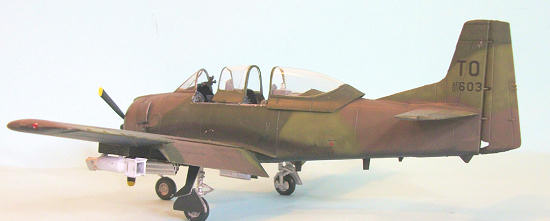 By the time Coleman was flying missions, the NVAs were running trucks on
the trail in groups of 3-4, rather than the convoys of 20-30 they had been
doing, making it harder to stop them.
Coleman found he wasn’t a “truck killer” like Drummond, and gained a
reputation for going after the defensive AAA.
He had a strategy for spotting the guns: “You’d watch the guy ahead of
you going in, and spot the guns when they opened up on him.”
As Coleman recalled, “It was easiest to spot a gun with an untrained
gunner who would fire straight up, experienced gunners didn’t do that.”
Pilots called full moon
By the time Coleman was flying missions, the NVAs were running trucks on
the trail in groups of 3-4, rather than the convoys of 20-30 they had been
doing, making it harder to stop them.
Coleman found he wasn’t a “truck killer” like Drummond, and gained a
reputation for going after the defensive AAA.
He had a strategy for spotting the guns: “You’d watch the guy ahead of
you going in, and spot the guns when they opened up on him.”
As Coleman recalled, “It was easiest to spot a gun with an untrained
gunner who would fire straight up, experienced gunners didn’t do that.”
Pilots called full moon
nights “the gunner’s moon.”
There were multiple AAA used for defense of the trail.
“The deadliest was the ZPU‑23,” Coleman remembered.
“It had four 23mm cannon in a single mount, and they didn’t fire tracer.
You could spot them from the
‘flower pattern’ of the
muzzle blast.
You could tell 50
caliber from 37mm by the color of the tracers. One 37mm hit was all it took to
knock down a T‑28.
The O-2As were
OK, but if one of them got hit in the rear engine, he wasn’t going home.”
Originally, the strategy had been for an AT-28 to drop flares over that
part of the trail being attacked, and then keep the flare between the attacking
airplane and the ground targets.
By
late 1967, “There were so many guns, it was impossible to keep a flare between
you and the gunners.”
What seems incredible, looking back at these events, is the fact that the
606th never had more than ten AT-28Ds on hand at any particular time,
yet was responsible for the majority of “kills” on the Ho Chi Minh Trail during
the major expansion of the war in 1966-68. The reliability of the T-28 was what
made the operations possible, since there would be at least two aircraft over
the trail any given night.
Finally,
in early 1968, time started catching up with the airplanes.
As Coleman recalled, “They started finding major damage to the spars.
Even beefed up, these were light weight spars that had originally been
designed for an airplane - the T-28A - that had only about three-quarters the
weight of the AT-28D.
And the
engines started going bad.” In a one week period in February 1968, three
airplanes went down for engine failure, and two of the pilots were lost.
Coleman himself experienced an engine cutting out while on a mission.
“The possibility of losing an engine at night, over the Trail, would
definitely get your attention.”
None of the AT-28D pilots who bailed out over the Ho Chi Minh Trail ever made it
into a POW camp.
With the increasing wear and tear on the airframes and engines, and with
the performance of the AT-28D being insufficient to allow operations over the
more heavily-defended parts of the Ho Chi Minh Trail, where radar-directed AAA
became common after November 1967, the AT-28Ds were withdrawn from operations in
April 1968 and replaced by ex-Navy A-1G Skyraiders that had been modified for
the ELINT mission, then further modified for strike operations.
Even more than 40 years after the secret war over the Ho Chi Minh Trail, almost nothing has been written about Air Force AT-28D or 606th Special Operations Squadron operations during the period from October 1966 through March 1968. Officially, AT-28D aircraft were not used by the Air Force on operations in Southeast Asia after 1964. AT-28D operations from Nakhon Phanom AB supporting the secret war in Laos were not officially admitted until the late 1990s, and there are still aspects of the operation that former pilots cannot speak of today. All operations in Laos were credited to Royal Laotian Air Force T-28Ds, which did indeed fight on until the end of the war in Indochina in the spring of 1975.
| THE KIT |

| CONSTRUCTION |

| COLORS & MARKINGS |
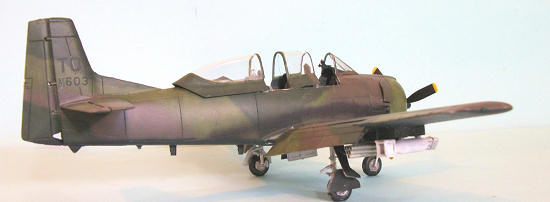
| FINAL CONSTRUCTION |
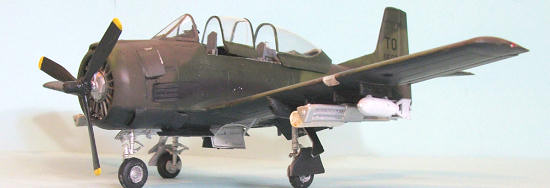
| CONCLUSIONS |
This is a nice kit that is not that hard to assemble with a good result.
It would be nice if some aftermarket decal company would come up with a
couple of sheets for the many schemes the T-28 flew in during its long career
both as a trainer and poor man’s fighter.
The model will look very good sitting next to the A-26 Nimrod
(Counter-Invader) I did a few years back, out at Planes of Fame.
Recommended for all who like the T-28, but get the upgrades for landing
gear and cockpit.
July 2012
Review kit courtesy of
HobbyLink Japan.
Order yours at:
http://www.hlj.com/product/ROD048T441
Thanks to Terry Dean for the
nose weight.
Order yours at
Nightimission@aol.com
If you would like your product reviewed fairly and fairly quickly, please contact the editor or see other details in the Note to Contributors.